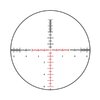Chuck R.
Member
Once you have used a reticle like the Burris SCR Mil pictured above with a good ballistic program, it's hard to go back.
Yes, I used to hold over and make hits like the first pic in VT's last post, but it sure is more precise doing it like his second pic ( or dialing it).
This isn't exactly rocket science, guys have been killing deer effectively (and ethically) with plain cross hairs for years. the reason his examples are showing the need for so much holdover is no doubt a 100yd zero. It would take a special kind of "rocket scientist" to set himself up for a possible 250yd shot with a 100yd zero and a standard duplex reticle.
I know the trend is for guys to wanna play deer sniper but your chitting me IF you say a mil dot scope is a requirement to kill deer at 250 yards "ethically"

The vast majority of commonly used bottle-neck cartridge that are sighted in at 200 yds, will still be within a deer's "kill zone" at 250yds with a "dead hold", my .270 drops 2.3" at 250 from a 200 zero and my .260 is slightly over 3" drop. Shade high and you're "golden" a 10MPH 9 o'clock is roughly 4.5" at 250, again a slight shading and you're making meat.
Like I said before, more precise definitely, needed to kill a deer at the most common distances deer are actually killed.. not a chance in hell.



